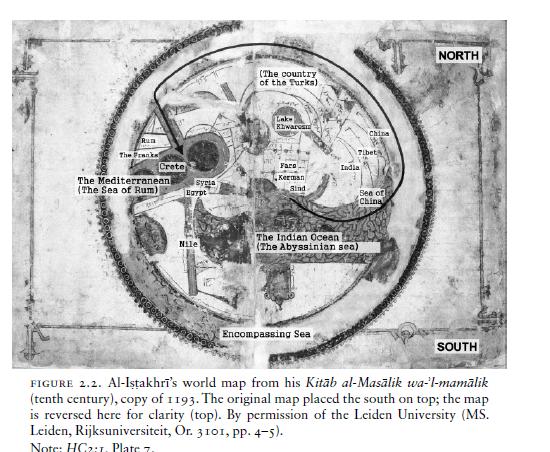Ethiopian Boat Arrives in the Mediterranean?! November 20, 2014
Author: Beach Combing | in : Medieval , trackbackHere’s a strange text to say the least. It appears in that remarkable tenth-century Arab work Meadows of Gold and Mines of Gems by Abu Zayd, the kind of miscellany of marvels that only the Arabs could write: the non-fiction reflex of Sinbad.
In the Sea of Rum [the Mediterranean] near the island of Iqritish [Crete, almost certainly], planks of ships of Indian teak, which were perforated and stitched together with fibers of the coconut tree, were found. They were of ships that had been wrecked and tossed about by the waves from the waters of the seas.
Abu Zayd’s interest has been piqued by an early medieval wrong place object. Sailors in the Dark Age Mediterranean do not use Indian teak and you would have to travel to Ireland or, at least, the Irish sea to find folk who stitched boats together. What is going on here? Abu Zayd thinks he knows. The ship has somehow come from the sea off Ethiopia.
This [type of ship] exists only in the Abyssinian sea [the Indian Ocean] because all of the ships of the Sea of Rum and the west [some textual problems here] are nailed, while the ships of the Abyssinian sea are not fastened with iron nails, because the sea water dissolves the iron, so the nails become thin and weak in the sea. So people [of the Abyssinian sea] used stitching with fibers instead of the nails, and [the ships are] coated with grease and lime.
Next problem though. How did it get to Greece? Well, the navigators presumably used the Suez Canal and… But the Suez Canal was opened in 1869, a thousand years later. So this ship has somehow got around Euro-Asia. Two possibilities come to mind (other than the most credible of all that this is based on a misunderstanding): someone took the boat overland, for now forgotten reasons; or the boat had passed around the Cape of Good Hope (remember those Phoenicians). Abu would have laughed at both of these. Men don’t carry ships across deserts. He may have believed, too, that Africa touched the bottom of the world, as Ptolemy and his successors had. Could he have believed that the boat had passed across the Indian Ocean and made its way to Europe, in other words the reverse of the trip that Columbus had so wanted to carry out? The Arabs had refused the minority opinion found among some Christians that the globe was flat. But, of course, the ocean was too great to cross. So no. Well, apparently he believed something that is a little more incredible, namely that the boat had gone from Ethiopia around India, China, and then, ahem, past Siberia and up over the top of the world before coming down at Britain and entering the Mediterranean!
This proves, and God knows better, the connection of the seas, and that the sea near China and the country of Sila [Korea ] goes all round the country of the Turks, and reaches the sea of the west [the Mediterranean? Or better the Atlantic?] through some straits of the encircling ocean.
This at least is how Hyunhee Park interpreted it, in her fine Mapping the Chinese and Arabic Worlds, see the graphic above. There are some problems but she seems to have read the text correctly? drbeachcombing AT yahoo DOT com This is reminiscent of that fascinating arrival of ‘Indians’ among the Gauls on the Atlantic coast of Roman Europe. The globe is happily full of bizarreness.
29 Nov 2014: Judith from Zenobia writes Easy peasy, Beachcombing. Way back in pharaonic times, there was already a road in Egypt leading from the Nile valley across the Eastern Desert (the “road of Ten-pa-mer”, which means “the road belonging to the harbour’) to the harbour of Saww/Mersa Gawasis on the Red Sea. We have a map to prove it. As we now know, this port was the jumping-off point for deep-sea voyages to Punt, some 1,200-1,300 km (800 miles) away to the south. Punt itself has only been recently located — thanks to some cutting edge science — in what is now Eritrea. Those sea-going ships must have been dismantled for transport and carried by men and donkeys more than 150 km (95 miles) along the wadi routes of the eastern desert and then reassembled at the port. The full story (and the map) at Hatshepsut and the Turin Papyrus Map. The Ptolemies did much the same when they founded the port of Berenice on the Red Sea connected by road with Coptos on the Nile, which became a main trading point for products from Arabia and India. Since there was no timber at Bernice either, the ships would have been carried across the desert from Coptos — a journey of at least 11 days. Berenice flourished well into Roman times and only was abandoned and forgotten in the 6th C AD. Archaeologists have been digging there since 1994, with some spectacular results. In short, if dismantled ships could be carried in one direction, a relatively light sewn boat could certainly be carried in the other. The interesting point in Abu Zayd’s story (if not simply displaced from elsewhere) is the hint that the desert route might have been reopened in the 10th century, which is otherwise unknown and (for many reasons) unlikely. However, as President Erdogan of Turkey has just reminded us, no fantasy is too far-fetched if one closes ones eyes and really believes.sts have been digging there since 1994, with some spectacular results.’ thanks Judith!



